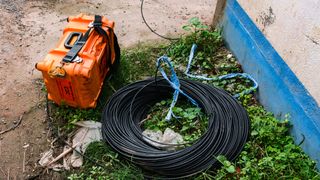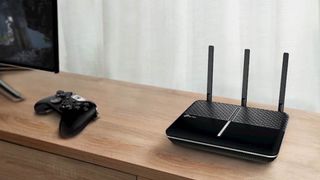How to increase internet speeds even if you have a slow internet provider
How to increase internet speeds when fiber isn’t available

There’s little in life more frustrating than slow internet, especially in the work from home age, so you may find yourself wondering how to increase internet speeds at your house. While some areas of the country wait for fiber lines, others still don’t have access to broadband speeds, leaving few options for faster, more reliable connections.
Channel bonding, in some cases, is the answer to this dilemma. Today we’ll discuss what it is, who it works for, and some of the drawbacks you might experience from channel bonding two internet connections in your home.
What Is Channel Bonding?
As its name implies, channel bonding is stitching multiple channels together to create one faster internet connection. It is accomplished by software or hardware used to distribute your web traffic among different internet providers. This distribution occurs at the packet level or when your data are segmented while traveling inside the internet.
You can liken channel bonding to a restaurant where your order is distributed to multiple chefs so they can prepare it faster. With channel bonding, your computer can have multiple internet providers ask for different parts of your request. Your provider’s returned data is then stitched back together by your channel bonding software or hardware.
What Are the Advantages and Disadvantages of Channel Bonding
Channel bonding is very effective in improving your internet speed. When bonded, the two channels work in parallel before combining to deliver (almost) twice as much data as your typical connection. Without channel bonding, even if you have two connections that provide 100 Mbps each, you will never exceed 100 Mbps as you are always connected to only one of them.

It also protects you from sudden disconnections as you are always connected to two or more providers simultaneously. If you have multiple connections you’re probably used to switching between them when one fails. Your channel bonding setup will take care of this for you. You’ll no longer have to worry about getting disconnected and switching to the network that’s currently online.
Unfortunately, channel bonding isn’t perfect. As we have already mentioned, it requires multiple internet connections to work. These connections can come from the same provider, but that means if one goes down it’s quite likely they both will. So you will need to subscribe to more than one internet plan for it to work, and ideally from different providers to avoid outages.
Stay in the know with Laptop Mag
Get our in-depth reviews, helpful tips, great deals, and the biggest news stories delivered to your inbox.
The ideal solution, if it’s available to you, is just one fast fiber or broadband connection. But as we mentioned previously, this isn’t always possible.

To use channel bonding, you may also need to purchase a wi-fi router that can do it for you. Another option would be to download an application or software that can do server-side channel bonding. Whether you elect to go with a hardware or software solution, both come at a cost.
Different Ways to Do Channel Bonding
Channel bonding is accomplished in one of two ways. The first is by using hardware, whether it be a router or a dedicated PC to manage your connection. Another option -- and the best option for most people -- is a software solution. Each has its advantages and disadvantages, but the software solution usually comes at a lower cost (though it’s often a monthly subscription) and involves less maintenance and tinkering.
Let’s take a closer look at both options.
Using Hardware to Channel Bond
The hardware solution is most commonly done with a router. There’s no “right” way to bond two internet connections and solutions here are plentiful, but the common theme is that they all join a split connection into one at the end. The router accepts both connections, merges them, and treats them as one connection before sending a signal to your device(s).

One advantage of using hardware for channel bonding is that you can connect multiple devices, enjoying faster internet speeds from each. Software solutions often force you to pay per-device.
A disadvantage is that this isn’t usually a straightforward process for casual internet users. It’ll often require hours of tinkering to set it up and then ongoingmaintenance whenever something goes wrong. You may be better off hiring a network specialist to do it for you but that too comes at a cost.
Using Software to Channel Bond
If you are using a mobile device, whether it’s powered by Android, iOS, or another operating system, you can download applications to channel bond. Apps like Connectify, Mobolize and Net Optimizer allow your device to connect to Wi-Fi and mobile data simultaneously.
This is great if you like to use multiple devices, which is probably most of you reading this article. But unlike the hardware solution, you’ll rarely pay once for this. Software-based channel bonding solutions typically come with a monthly bill. Another negative is that monthly access isn’t always the most reliable, depending on which service you use. It’s a “you get what you pay for” space.
Is Channel Bonding Worth it?
Yes and no. Like all things technology, the answer really is “it depends.” If you can get a fiber connection, or a speedy broadband connection from your cable provider the answer is a resounding no. The extra cost and complication of channel bonding are definitely not worth it if you have these faster and more reliable options available
If you live in a place limited to DSL providers, however, then channel bonding could provide that speed boost you’ve been looking for, in addition to increased reliability -- assuming both connections aren’t coming from the same provider.
